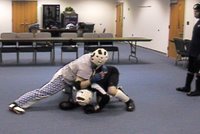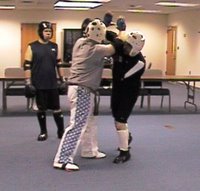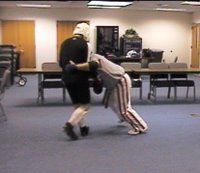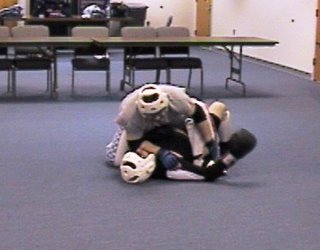
Participants: Nathan, Mike, Bobby
Great training today. We are moving toward our DT, self-defense, and ground work on pace. It was nice being able to project the live camera from the overhead, and I also used it to show some information from the blog, and how to do a bloger search of this site. I am also happy that I remembered to do the post-training debrief on camera to get everyone's thoughts and opinions.
After a brief warmup, we started by working on circling footwork, then I explained how to build combinations (high/low, inside/outside), and why they work.
Then on to the sucker punch. Agreed that fights typically start with a shove, grab and punch, or sucker punch, in this case, defined as a sudden attack with the fist to the head. Our focus today was the punch. Next week will be the shove (after drilling the punch again). To defend this, we:
- Maintained a minimum distance to allow you to block/parry a grab or punch
- Subtly assumed a "fighting stance" by placing one foot back, knees slightly bent, and hands up in a non-threatening (or "thoughtful") pose
- Kept eyes focused on the entire body using peripheral vision, and used non-threatening eye contact
 Techniques I recommended were: Wedge (dive position) block, lead palm strike/eye jab with high elbow to deflect the blow, and a simultaneous block and counter (palm to the nose/web-hand to the throat/palm to the forehead). I also showed how the forearm or elbow can be a part of the wedge block and used when entering.
Techniques I recommended were: Wedge (dive position) block, lead palm strike/eye jab with high elbow to deflect the blow, and a simultaneous block and counter (palm to the nose/web-hand to the throat/palm to the forehead). I also showed how the forearm or elbow can be a part of the wedge block and used when entering.
We drilled these as the lead-off fighter engaged the counter-fighter in conversation, then, when the CF (Counter-Fighter) was relaxed and less "on-guard", attacked with a fast overhand or wide right to the jaw.
 I mentioned that what we had picked up from our fighting versus an "untrained" opponent (See full post http://tdatraining.blogspot.com/2004/07/training-diary-sat-73104-self-def.html) was that an attack will be wild-blows raining from all directions, and that the typical martial arts blocks won't work, as untrained attackers throw reckless punches, and after the block they crash into you. We discussed the reality of being driven into a wall or other obstacle, and that you may be tackled. To counter that, I demonstrated the wedge defense, and the sprawl.
I mentioned that what we had picked up from our fighting versus an "untrained" opponent (See full post http://tdatraining.blogspot.com/2004/07/training-diary-sat-73104-self-def.html) was that an attack will be wild-blows raining from all directions, and that the typical martial arts blocks won't work, as untrained attackers throw reckless punches, and after the block they crash into you. We discussed the reality of being driven into a wall or other obstacle, and that you may be tackled. To counter that, I demonstrated the wedge defense, and the sprawl.
After demonstrating the feint, fake, and drawing, we drilled the  check and half-trap. We did some rounds with them versus a lead-off fighter's jab.
check and half-trap. We did some rounds with them versus a lead-off fighter's jab.
Finally, burnout sparring and stretching. Great day!
Selected info from the "untrained post mentioned above:
... we did something I've wanted to do for a long time. We practiced fighting an untrained opponent. At least, we tried to do our best to seem untrained...
... it was a very interesting time. Sam seemed a little blown away by how different it was. As an attacker, my techniques were to try to tackle, and two punches: wide right haymaker, and wide left haymaker. I didn't try to grab as much as Sam did, but I should've tried to grab and punch him. I tried a couple of tackle/takedowns. Sam (as attacker) tried tackling, wide punches, and grabbing me.The idea was to give the attacker the initiative and see what worked.
Summary of effective defenses and techniques that we tried:
Vs. Tackle: Angle off and push the attacker's head so that he careens to the side.
Vs. Right haymaker: duck under and attack from the side or behind.
Vs. Infighting: Dive position blocking, then grab attacker behind the neck and pull into the knee and elbows.
Stop-hit the wide shot with a jab: All the straight punches I threw worked pretty well when I could get in position to throw them. If you follow the quick hard jab with a follow-through right, I think this is when you could move into position for a throw. I want to work on that more. I told Sam that when I was throwing the jab, I was visualizing using either the jab to the nose, or a strike to the throat. Sam commented that this was very effective against him.
Leg-kicking: I tried it only a couple of times, but it seemed very effective. Sam commented that when he was throwing a right and I sidestepped and leg-kicked, that if I'd landed hard it would've taken him off his feet.
Grab and knee: We both used this to good effect. If an opponent is flailing with punches and wants to get inside, the best thing was to let him in, block his punches
while clinching behind the neck, then repeatedly kneeing to the thighs, groin
and midsection.
Lateral movement: Seems like just movement threw off the attacker quite a bit.What didn't work:
The standard block, then counter: Problem was, when you block the first one, the second one is already on the way. The effect of the block is to stop your counter as well as the opponent's attack. In other words, it's a temporary stale-mate. Better to counter as a defense.
Moving straight back: This should be a no-brainer, 'cause it never works, but if you're back on your heels, you're gonna be gettin' hit.
Standing there and slugging it out: You may as well be untrained too, if you do this. It takes away all the advantages of your superior skill. Don't do this! Both of us had a lot of trouble when we stopped and just tried to duke it out.Let's try this next time:
- Start out at close range. We don't like this because we don't have time to prepare. This could best be done with a third person to say, "Go!".
- Start out from a grab. Say you're pinned against the wall and about to be hit or just choked out. Again, have someone start us off.
- Versus a club or knife. This is going to take a lot of work. Sounds like fun.
- Sprawl versus a takedown/tackle attempt.
- Work throws and sweeps into the mix.
- Work the leg-kicks a lot more.
- Experiment with high-kicks.
- Work the backfist and spinning backfist into this.
- Start in a sitting, prone, or even grappling position


No comments:
Post a Comment